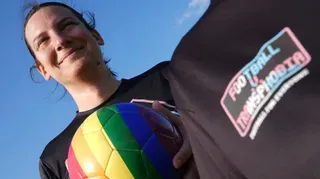July 7, 2012
Schools Miss Mark on Youth HIV Education
Francisco L. White READ TIME: 4 MIN.
The statistics regarding the HIV/AIDS pandemic, especially as they apply to young people in the United States, are arguably more alarming than ever. So, a recent press release from the National Minority AIDS Council may come as an unpleasant surprise to many; generally, the demographic most in need of prevention by education is not getting it.
"More than 8,000 young people in the U.S. aged 13 to 24 were newly infected with HIV in 2009. Half of all new sexually transmitted infections are among young people, aged 15 to 24," said Kali Lindsey, director of Legislature and Public Affairs for the National Minority AIDS Council. "As such, it is critical that we provide comprehensive and evidence-based sexual education to our youth before they become sexually active. Today's report from the CDC shows that we are failing our children. We must do better."
According to the 2011 National Youth Risk Behavior Survey (YRBS), released by the U.S. Centers for Disease Control and Prevention (CDC), "the percentage of U.S. high school students who had learned about HIV/AIDS in school dropped from 91.5 percent in 1997 to 84 percent in 2011. At the same time, only 60 percent of young people reported using a condom during their last sexual encounter."
Indeed, the statistics are indicative of schools generally failing to adequately inform or empower young people to make safer decisions about sexual activity. Despite what these numbers show, there are individuals, agencies and organizations making notable effort. In Massachusetts, for example, the Department of Elementary and Secondary Education established a policy on HIV education in 1990 and 1991 that is still in effect. But they are presented with a financial challenge.
"There have been reductions in state funding for health education since 2003," explained Jonathan Considine, director of Board and Media Relations. "The Department used to receive over $25 million per year in state tobacco tax money. Most of that money went to local school districts to support health education, including HIV education."
Although that funding stream may have dried up, Considine emphasized the Department's continued commitment to HIV youth education and prevention efforts, despite financial constraints.
"With the funding we have, the Department provides professional development and technical assistance to schools and districts on implementing effective HIV education. We focus our efforts on the most highly impacted communities," said Considine. "We do most of our work with urban districts that have high teen birth and STD rates. Our professional development outreach includes information on reaching racial and ethnic minority students. All of our work also includes reaching LGBT youth, as they are at greatest risk for HIV."
Difficulty Bridging the Gaps
There is no state-mandated curriculum in Massachusetts, which means health education varies and, ultimately, may be found lacking in certain communities.
"Decisions [about] curriculum, what textbooks to purchase and use, etc. are made locally. In other words, the decisions about health and HIV education rest with local school committees," said Considine.
Even in the Greater Boston area, some have noticed a decline in school-based HIV education. Moreover, community-based youth organizations are facing the difficult task of bridging the gaps, while dealing with financial struggles of their own.
"In the past, most of our youth were getting the education through school, but I have noticed the decline in sex and health education," said Mariama White-Hammond, executive director of the Boston-based youth organization Project Hip-Hop. "As a young person, I did peer education in the '90s, so I know how effective it was for my generation of teens. I think it is a big problem that many of the youth organizations that used to do that work have seen a major decline in their funding or have moved onto other important health issues and have ended up dropping much of the HIV/AIDS work."
She said that, in the past, her organization has brought in workshop speakers and had an extended conversation around women and AIDS because of the high rates of infection in young Black women.
To bridge the gap, community-based health and advocacy organizations are doing what they can, through substantial funding and collaboration. Fenway Health, a beacon of light to Boston's HIV/AIDS affected community and a reputed leader in LGBT healthcare, offers several confidential testing options as well as an LGBT youth hotline.
AIDS Action Committee collaborates with Partners in Education and Planned Parenthood on a program called Positive Educators Reaching Youth [PERY], which "recruits, trains and supports HIV-positive speakers to conduct developmentally appropriate education and HIV awareness with youth." PERY educators go into "schools, summer camps, teen living centers and youth residential programs to speak to adolescents about their experiences."
Time will tell if community-based organizations will make up for the lack of HIV/AIDS education in schools that is the result of decreased funding. As for Massachusetts, Considine says the Department of Elementary and Secondary Education "has not changed its commitment to HIV education." As of now, despite the reason, schools are dropping the ball and it's the youths who are losing.






